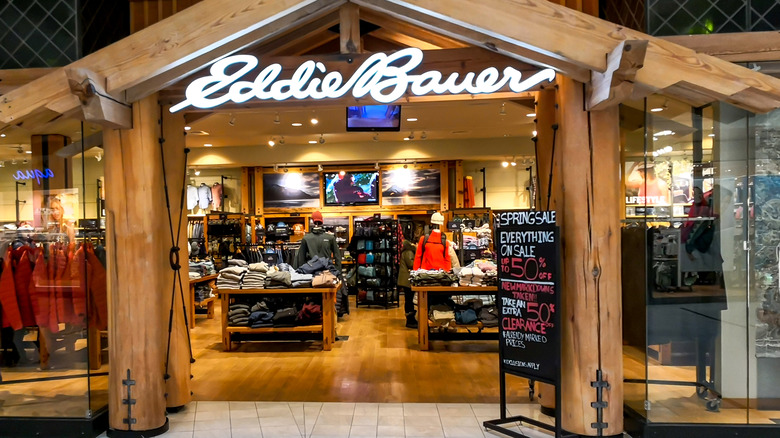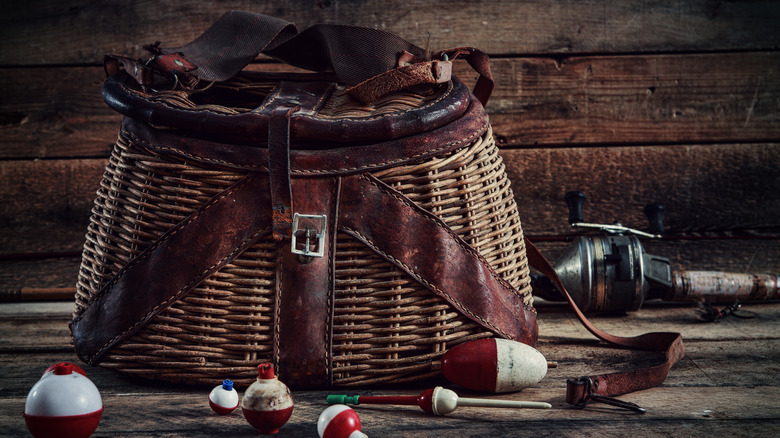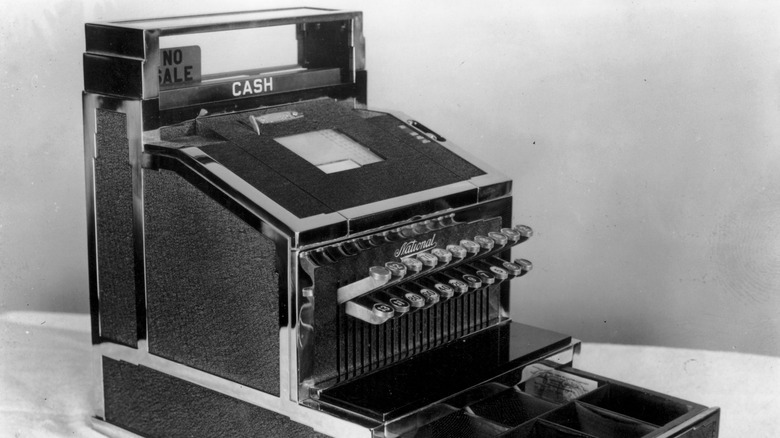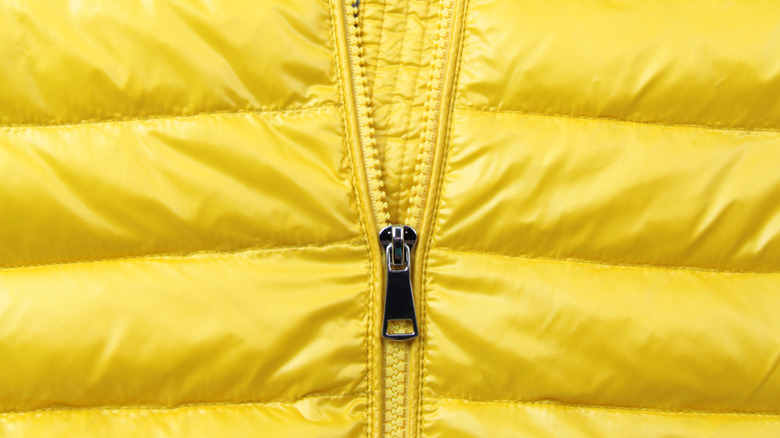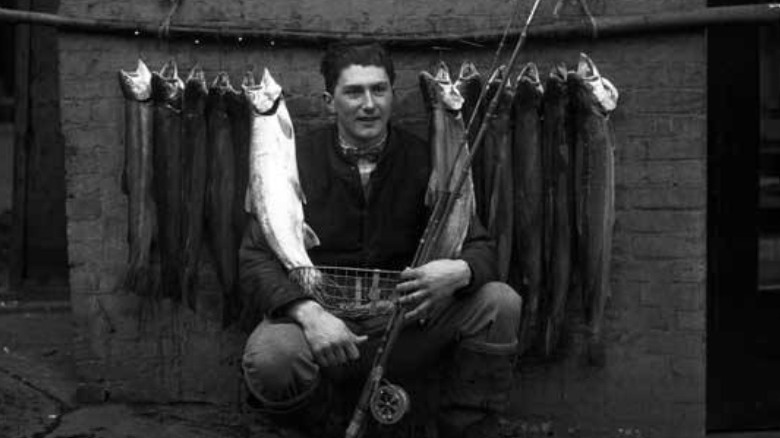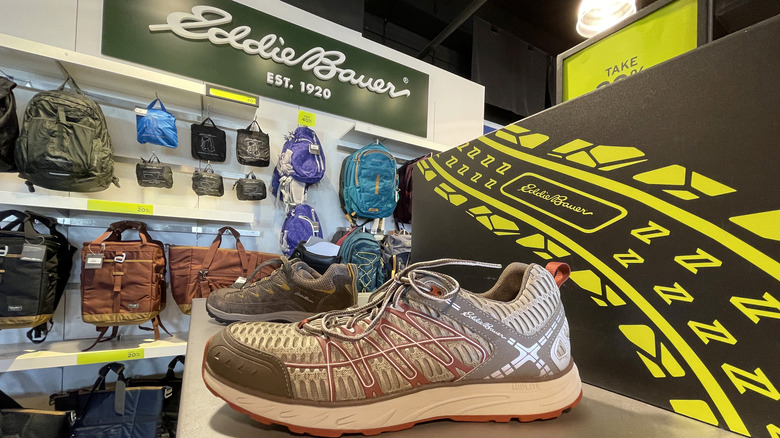Who Was The Real Eddie Bauer?
Over the decades, fashion trends have come and gone, and sometimes have even come back. And note that here we're not just talking about the garments themselves — parachute pants and leggings, for example — but also the designers of those products. Jordache jeans were huge in the 1980s, but nowadays they're just another brand on the shelves.
You would think that practical outdoors clothing, such as sweaters and hiking boots, would hardly be a fashion trend, but Eddie Bauer clothes were and are, just with a rather niche demographic. InStyle suggests that the brand makes consumers think of dads, "[the consumer] that values practicality and effortlessness and might be overly concerned with how much air is in your tires."
Eddie Bauer's product line may not appeal to fashionistas, and the number of people who buy his products for outdoor adventuring (as opposed to just daily use) may be rather limited. But there's something to be said about comfortable, functional clothing. And the real Eddie Bauer, the man whose name adorns the clothing line, was a real person whose innovations not only helped casual outdoorsmen and -women (or those who simply like his products), according to his company's website, he also helped soldiers stay warm during World War II.
Eddie Bauer and a childhood outdoors
In the heady days of the late 1890s, Seattle was known as a rough-and-tumble logging town. Eddie Bauer was born outside of town, at the bottom of Mount Constitution on Orcas Island in Puget Sound, according to The Manual, in 1899 (per History Link).
Young Eddie was all about hunting and fishing. Historian Colin Berg said that Eddie knew how to fish before he started school, and had mastered hunting before he was a teen. He also didn't consider his rural, outdoorsy life as shameful, and he "took great pride" in having been born in a cabin, as The Manual writes.
School and Bauer weren't the right fit, and at the age of 14 he dropped out and moved down Puget Sound to the Big City (as much as it was at the time) and went to work at a Seattle sporting goods store. There, he apprenticed with "the best hunters and fishermen in the Pacific Northwest," as Berg describes it. A few years later, at the age of 20, he opened up his own sporting goods store.
Business beckons
Before opening his own shop, according to the Eddie Bauer website, the young businessman spent a year operating out of another man's gun shop, hand-stringing and selling tennis rackets. Later, he opened up Bauer's Sports Shop, and it became the city's biggest sporting goods store. In addition to tennis rackets, according to History Link, he sold golf clubs and fishing tackle, and later developed an improved badminton shuttlecock that would become the industry standard.
Bauer's approach to business would make modern-day businessmen and -women blanch: the first year his shop was open, around Labor Day, according to The Manual, Bauer closed the doors and put up a sign saying the business was closed until the following February — he had gone hunting. Locking up your doors for months at a time is not best practice when building a business, but Bauer didn't care. For one thing, he went into business for himself specifically so he could come and go as he pleased; and for another, he considered his hunting trips business trips, since it was in the field (literally) that he conceptualized some of his innovations. "Extended fishing and hunting trips were his laboratory," Berg said. It was a 1923 hunting trip that set into motion the series of events that would make Eddie Bauer a household name.
The military asks for Bauer's help
In 1923, according to History Link, Bauer and a companion went hunting. At some point, as Sports Classics Daily explains, he and his partner got separated, and the weather conditions deteriorated to the point that his clothes were wet and cold, and he was in danger of dying of hypothermia. Fortunately, he was rescued in time, but that got him thinking about the need for better thermal outdoor gear — which, at the time, was mostly made from wool.
Bauer remembered that he had an uncle who had fought for the Russians in the Russo-Japanese War. The veteran remembered the down garments that soldiers wore as protection against the brutal winters. But there was a problem: down was (and is) heavy and bulky. Bauer eventually landed on quilting the garments, which reduced the weight. For the first time, Americans could wear lightweight garments that would protect the wearer in sub-zero temperatures.
Soon the U.S. military became interested, and Bauer got orders for down flight suits, sleeping bags, and other equipment, according to Sports Classics Daily and the Eddie Bauer website. When his supplies of materials were depleted due to the privations of war, he experimented, and largely succeeded, using other materials that were available, such as chicken feathers. Bauer ended up applying for over 20 patents for his products.
Marriage that was true companionship
Turn-of-the-century women in the Pacific Northwest apparently missed the memo that hunting and fishing are the domain of men, because one of Eddie Bauer's hunting trips was stymied by a woman whose group got there first. As The Manual reports, in 1927 Bauer (pictured above, in 1926) went to his favorite hunting spot, only to find a group already there. He was salty at first, until Christine Heltborg, who had come along as the camp cook, caught his eye. Soon Christine (Eddie called her "Stine") and the businessman were camping, hunting, and fishing together, and Stine proved adept at it all. In particular, when it came to marksmanship, she was a true dead-eye. "Here was this attractive young woman who could talk the talk with all the men, but outshoot and outfish most of them," Berg wrote.
Soon enough she was encouraging her husband to add women's gear to his inventory. By 1944, according to the Eddie Bauer website, the company was selling women's down jackets that included the models the Yukon and the Skyliner.
Times change, and so do companies
In 1968, according to History Link, Bauer, who had made several fortunes, sold his company to some investors and promptly retired. What followed was a decades-long tale of the brand expanding, being sold, expanding further, and being sold again. By the 1990s, the brand had expanded beyond sporting goods and into infant car seats, eyeglasses, and even bedding. The brand retained at least some connection to its beginnings as a clothing outfitter, although the merchandise at the time was less sporting goods and more "casual lifestyle apparel," as History Link notes.
In May 2021, as Forbes reported, the brand merged with a holding company that also includes Brooks Brothers, Lucky Brand, Forever 21 and Aeropostale. Meanwhile, if the Eddie Bauer website is any indication, the brand is looking towards a bright future that includes sustainability practices and inclusivity. "We're just getting started!," the brand notes on its website. The company still sells its bread-and-butter products, including parkas and outerwear, as well as more casual items such as pants and T-shirts.
As for the man himself? His wife, Stine, whom Bauer called his "wilderness companion," died of pancreatic cancer in 1986. They had been married for 56 years. Bauer himself died of a heart attack two weeks later, according to History Link. They were survived by their son.
